- Home
- Michael Chabon
Bookends Page 2
Bookends Read online
Page 2
The Long Ships, Frans G. Bengtsson
IN MY CAREER AS A READER I HAVE ENCOUNTERED ONLY three people who knew The Long Ships, and all of them, like me, loved it immoderately. Four for four: from this tiny but irrefutable sample I dare to extrapolate that this novel, first published in Sweden during the Second World War, stands ready, given the chance, to bring lasting pleasure to every single human being on the face of the earth.
The record of a series of three imaginary but plausible voyages (interrupted by a singularly eventful interlude of hanging around the house) undertaken by a crafty, resourceful, unsentimental, and mildly hypochondriacal Norseman named “Red Orm” Tosteson, The Long Ships is itself a kind of novelistic Argos aboard which, like the heroes of a great age, all the strategies deployed by European novelists over the course of the preceding century are united—if not for the first, then perhaps for the very last time. The Dioscuri of nineteenth-century Realism, factual precision and mundane detail, set sail on The Long Ships with nationalism, medievalism, and exoticism for shipmates, brandishing a banner of nineteenth-century Romance; but among the heroic crew mustered by Frans Bengtsson in his only work of fiction are an irony as harsh and forgiving as anything in Dickens, a wit and skepticism worthy of Stendhal, an epic Tolstoyan sense of the anti-epic, and the Herculean narrative drive, mighty and nimble, of Alexander Dumas. Like half the great European novels it is big, bloody, and far-ranging, concerned with war and treasure and the grand deeds of men and kings; like the other half it is intimate and domestic, centered firmly around the seasons and pursuits of village and farm, around weddings and births, around the hearths of women who see only too keenly through the grand pretensions of men and bloody kings.
It offers, therefore—as you might expect from a novel with the potential to please every literate human being in the entire world—something for everyone, and if until now The Long Ships has languished in the secondhand bins of the English-speaking world, this is certainly through no fault of its author, Frans Bengtsson, whom the reader comes to regard—as we come to regard any reliable, capable, and congenial companion in the course of any great novel, adventure, or novel of adventure—as a friend for life. Bengtsson re-creates the world of AD 1000, as seen through the eyes of some of its northernmost residents, with telling detail and persuasive historiography, with a keen grasp of the eternal bits that pebble the record of human vanity, and with the unflagging verve of a born storyteller—but above all, and this is the most remarkable of the book’s many virtues, with an intimate detachment, a neighborly distance, a sincere irony, that feels at once ancient and postmodern. It is this astringent tone, undeceived, versed in human folly, at once charitable and cruel, that is the source of the novel’s unique flavor, the poker-faced humor that is most beloved by those who love this book. Though at times the story, published in two parts each consisting of two parts over a span of several years, has an episodic feel, each of its individual components’ narratives is well-constructed of the soundest timbers of epic, folktale, and ripping yarn, and as its hero grows old and sees his age passing away, that episodic quality comes to feel, in the end, not like some congeries of saga and tall tale but like the accurate representation of one long and crowded human life.
Nor can blame for the neglect of The Long Ships be laid at the feet of Bengtsson’s English translator, Michael Meyer, who produced a version of the original the faithfulness of which I leave for the judgment of others, but whose utter deliciousness, as English, I readily proclaim. The antique chiming that stirs the air of the novel’s sentences (without ever overpowering or choking that air with antique dust) recalls the epics and chronicles and history of our mother tongue (a history after all shared, up to a point, with the original Swedish), and the setting of parts of the action in Dark-Ages Britain further strengthens the reader’s deceptive sense that he or she is, thanks to the translator’s magic and art, reading a work of English literature. Toss in the novel’s unceasing playfulness around the subject of Christianity and its relative virtues and shortcomings when compared to Islam, and, especially, to the Old Religion of the northern forests (a playfulness that cannot disguise the author’s profound but lightly worn concern with questions of ethics and the right use and purpose of a life), and the startling presence, in a Swedish Viking story, of a sympathetic Jewish character, and you have a work whose virtues and surprises ought long since have given it a prominent place, at least, in the pantheon of the world’s adventure literature if not world literature full stop.
The fault, therefore, must lie with the world, which, as any reader of The Long Ships could tell you, buries its treasures, despises its glories, and seeks contentment most readily in the places where it is least likely to be found. Fortunately for us, it is in just those unlikely places, as Red Orm quickly learns, that the opportunities and treasures of the world may often be found. My encounter with The Long Ships came when I was fourteen or fifteen, through the agency of a true adventurer, my mother’s sister, Gail Cohen. Toward the end of the sixties she had set off, with the rest of her restless generation of psychic Vikings, on a journey that led from suburban Maryland, to California where she met and fell in love with a roving young Dane, to Denmark itself, where she settled and lived for twenty years. It was on one of her periodic visits home that she handed me a UK paperback edition of the book, published by Fontana, which she had randomly purchased at the airport in Copenhagen, partly because it was set in her adopted homeland, and partly because there was nothing on the rack that looked any better. “It’s really good,” she assured me, and I would soon discover for myself the truth of this assessment, which in turn I would repeat to other lucky people over the years to come. Gail’s own adventure came to an end at home, in America, in the toils of cancer. When she looked back at the map of it, like most true adventurers, she saw moments of joy, glints of gold, and happy chances like the one that brought this book into her hands. But I fear that like most true adventurers—but unlike Bengtsson’s congenitally fortunate hero—she also saw, looking back, that grief overtopped joy, that trash obscured the treasure, that, in the end, the bad luck outweighed the good.
That is the great advantage, of course, that reading holds over what we call “real life.” Adventure is a dish that is best eaten takeout, in the comfort of one’s own home. As you begin your meal, as you set off with Frans Bengtsson and Red Orm and the restless spirit of my aunt, I salute you, and bid you farewell, and even though I have just finished reading the book for the fourth time, I envy you the pleasure you are about to find in the pages of The Long Ships. When you arrive at its bittersweet, but mostly sweet, conclusion, I trust that you will turn to your shipmate, your companion in adventure, and swear by ancient oaths, as I hereby swear to you: It is really good. (2010)
Superheroes: Fashion and Fantasy, Andrew Bolton
Secret Skin
An Essay in Unitard Theory
THE DANGER OF THE CAPE
WHEN I WAS A BOY, I HAD A RELIGIOUS-SCHOOL TEACHER named Mr. Spector whose job was to confront us with the peril we presented to ourselves. Jewish Ethics was the name of the class. We must have been eight or nine.
Mr. Spector used a workbook to guide the discussion; every Sunday, we began by reading a kind of modern parable or cautionary tale, and then contended with a series of imponderable questions. One day, for example, we discussed the temptations of shoplifting; another class was devoted to all the harm to oneself and to others that could be caused by the telling of lies. Mr. Spector was a gently acerbic young man with a black beard and black Roentgen-ray eyes. He seemed to take our moral failings for granted and, perhaps as a result, favored lively argument over reproach or condemnation. I enjoyed our discussions, while remaining perfectly aloof at my core from the issues they raised. I was, at the time, an awful liar, and quite a few times had stolen chewing gum and baseball cards from the neighborhood Wawa. None of that seemed to have anything to do with Mr. Spector or the cases we studied in Jewish Ethics. All nine-year-olds are so
phists and hypocrites; I found it no more difficult than any other kid to withhold my own conduct from consideration in passing measured judgment on the human race.
The one time I felt my soul to be in danger was the Sunday Mr. Spector raised the ethical problem of escapism, particularly as it was experienced in the form of comic books. That day, we started off with a fine story about a boy who loved Superman so much that he tied a red towel around his neck, climbed up to the roof of his house, and, with a cry of “Up, up, and away,” leaped to his death. There was known to have been such a boy, Mr. Spector informed us—at least one verifiable boy, so enraptured and so betrayed by the false dream of Superman that it killed him.
The explicit lesson of the story was that what was found between the covers of a comic book was fantasy, and “fantasy” meant pretty lies, the consumption of which failed to prepare you for what lay outside those covers. Fantasy rendered you unfit to face “reality” and its hard pavement. Fantasy betrayed you, and thus, by implication, your wishes, your dreams and longings, everything you carried around inside your head that only you and Superman and Elliot S! Maggin could understand—all these would betray you, too. There were ancillary arguments to be made as well, about the culpability of those who produced such fare, sold it to minors, or permitted their children to bring it into the house.
These arguments were mostly lost on me, a boy who consumed a dozen comic books a week, all of them cheerfully provided to him by his (apparently iniquitous) father. Sure, I might not be prepared for reality—point granted—but, on the other hand, if I ever found myself in the Bottle City of Kandor, under the bell jar in the Fortress of Solitude, I would know not to confuse Superman’s Kryptonian double (Van-Zee) with Clark Kent’s (Vol-Don). Rather, what struck me, with the force of a blow, was recognition, a profound moral recognition of the implicit, indeed the secret, premise of the behavior of the boy on the roof. For that fool of a boy had not been doomed by the deceitful power of comic books, which after all were only bundles of paper, staples, and ink, and couldn’t hurt anybody. That boy had been killed by the irresistible syllogism of Superman’s cape.
One knew, of course, that it was not the red cape any more than it was the boots, the tights, the trunks, or the trademark “S” that gave Superman the ability to fly. That ability derived from the effects of the rays of our yellow sun on Superman’s alien anatomy, which had evolved under the red sun of Krypton. And yet you had only to tie a towel around your shoulders to feel the strange vibratory pulse of flight stirring in the red sun of your heart.
I, too, had climbed to a dangerous height, with my face to the breeze, and felt magically alone of my kind. I had imagined the streak of my passage like a red-and-blue smear on the windowpane of vision. I had been Batman, too, and the Mighty Thor. I had stood cloaked in the existential agonies of the Vision, son of a robot and grandson of a lord of the ants. A few years after that Sunday in Mr. Spector’s class, at the pinnacle of my career as a hero of the imagination, I briefly transformed myself (more about this later) into a superpowered warrior-knight known as Aztec. And all that I needed to effect the change was to fasten a terry-cloth beach towel around my neck.
THE SECRET ORIGIN OF UNITARD THEORY
IT WAS NOT ABOUT ESCAPE, I WANTED TO TELL MR. SPECTOR, thus unwittingly plagiarizing in advance the well-known formula of a (fictitious) pioneer and theorist of superhero comics, Sam Clay. It was about transformation.
AND THE SECRET ANXIETY OF ORIGIN
IT IS COMMONPLACE TO ASSERT THE HERITAGE OF THE COSTUMED heroes of comic books in the misty mythosphere of the ancient world, and it’s tempting to view accounts of superhero origins, the sine qua non of the superhero narrative, as proof of that legendary inheritance. Hyperbolic myths of origin have from the mistiest times served to lend a paradoxical plausibility to the biographies of heroes. Baskets found floating in the bulrushes, oracle-doomed infants abandoned on hillsides, babies born with hammers in their hands. Traditional origin myths affirm the constant, even prenatal, presence of the marvelous in the hero’s life, of a vein of wonder that marbles it from one end to the other like the words embedded in a stick of Brighton rock.
But apart from a marked tendency to orphanhood, the superhero generally disappoints the expectations of mythology. The costumed hero—if not a mutant—is born powerless and unheralded like the rest of us. It takes the bite of a radioactive spider, or some other form of half-disaster (a lab explosion, a brutal act of street violence, a secret government experiment, an emergency transfusion of mongoose blood) to give birth to the hero, who then springs, full-grown like Athena, from the prised-open cranium of everyday life. The superhero works long hours at a day job (even that playboy Bruce Wayne puts in an awful lot of time at the office) and struggles in every way—legally, socially, emotionally—to fit in to the expectations of the quotidian world. The superhero in general has no overt or obligatory sense of destiny, none of the lust for glory and fame and treasure that characterize the classical hero. Superheroes spend a lot of time wishing they could just stay home, spend time with their families and loved ones, date the girl they love, be like everybody else. They excel because they cannot help it, or because it would be wrong not to, or because they need to prove their worth, or to exonerate themselves, or to repay the debt they feel to society, their parents, the wizard in a subway tunnel who endowed them with magic might. Above all, superheroes have secret identities; they have lives and natures that their pursuit of heroism obliges them to conceal, to downplay, to deny. They cannot engage in the boastful trumpeting of one’s name and parentage so beloved among traditional heroes.
It is for this reason, and not out of their legendary heritage in the mythosphere, that comic books, the bastard child of newspaper strips and pulp magazines, have always displayed an arriviste fixation on questions and mysteries of origin. The superhero is a parvenu in the house of adventure, an immigrant on the shores of myth.
This general fixation with the origin story goes beyond the particulars of Kryptonian birth or gamma-ray exposure to encompass the origin of the idea of the costumed superhero itself. Fans and historians of comic books (those synonymous creatures) have devoted loving years and pages in the thousands to isolating with some kind of precision the moment and the conditions that led to the birth of the costumed hero. And when they faltered in their efforts, in have strode the psychologists, the critics, the analysts, and, with mixed results, the comic book writers and artists themselves.
The comic book preexisted the superhero, but so barely and with so little distinction that the medium has seemed indistinguishable in the cultural mind from its first stroke of brilliance. There were costumed crime fighters before Superman (the Phantom, Zorro), but only as there were pop quartets before the Beatles. Superman invented and exhausted his genre in a single bound. All the tropes, all the clichés and conventions, all the possibilities, all the longings and wishes and neuroses that have driven and fed and burdened the superhero comic over the past seventy years were implied by and contained within that little red rocket ship hurtling toward Earth. That moment—Krypton exploding, Action Comics #1—is generally seen to be Minute Zero of the superhero idea.
About the reasons for the arrival of Superman at that zero moment there is less agreement. In the theories of origin put forward by fans, critics, and other origin-obsessives, the idea of Superman has been accounted the offspring or recapitulation, in no particular order, of Frederic Nietzsche; of Philip Wylie (in his novel Gladiator); of the strengths, frailties, and neuroses of Jerry Siegel and Joe Shuster; of the aching wishfulness of the Great Depression; of the (Jewish) immigrant experience; of the mastermind stratagems of popular texts in their sinister quest for reader domination; of repressed Oedipal fantasies; of fascism; of capitalism; of the production modes of mass culture (and not in a good way); of celebrated strongmen and proponents of physical culture like Eugene Sandow; and of a host of literary not-quite-Supermans (chief among them Doc Savage) who preceded him.
&nb
sp; Most of these rationales of origin depend, to some extent, on history; they index the advent of Superman in late 1938 to various intellectual, social, and economic trends of the Depression years, to the influence or aura of contemporary celebrities and authors, to the structure and demands of magazine publishing and distribution, et cetera. To suit my purpose here I might construct a similar etiology of the superhero costume, making due reference, say, to professional wrestling and circus attire of the early twentieth century, to the boots-cloak-and-tights ensembles worn by swashbucklers and cavaliers in stage plays and Hollywood films, to contemporary men’s athletic wear with its unitard construction and belted trunks, to the designs of Alex Raymond and Hal Foster and the amazing pulp-magazine cover artist Frank R. Paul. I could cite the influence of Deco and Streamline design aesthetics, with their roots in fantasies of power, speed, and flight, or posit the costume as a kind of fashion alter ego of the heavy, boxy profile of men’s clothing at the time.

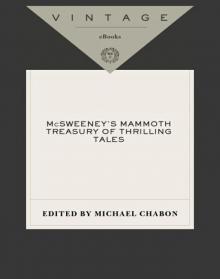 McSweeney's Mammoth Treasury of Thrilling Tales
McSweeney's Mammoth Treasury of Thrilling Tales The Amazing Adventures of Kavalier & Clay
The Amazing Adventures of Kavalier & Clay The Yiddish Policemen's Union
The Yiddish Policemen's Union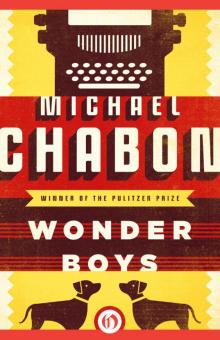 Wonder Boys
Wonder Boys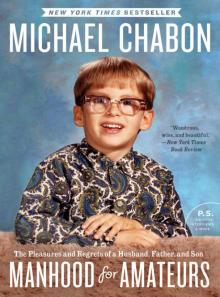 Manhood for Amateurs
Manhood for Amateurs Kingdom of Olives and Ash: Writers Confront the Occupation
Kingdom of Olives and Ash: Writers Confront the Occupation Gentlemen of the Road: A Tale of Adventure
Gentlemen of the Road: A Tale of Adventure A Model World and Other Stories
A Model World and Other Stories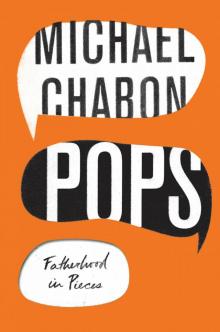 Pops: Fatherhood in Pieces
Pops: Fatherhood in Pieces McSweeney's Enchanted Chamber of Astonishing Stories
McSweeney's Enchanted Chamber of Astonishing Stories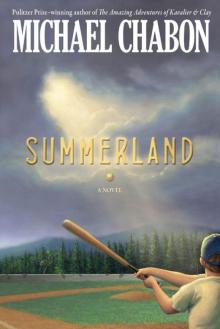 Summerland
Summerland Telegraph Avenue
Telegraph Avenue The Final Solution
The Final Solution The Mysteries of Pittsburgh
The Mysteries of Pittsburgh Werewolves in Their Youth
Werewolves in Their Youth Bookends
Bookends Fight of the Century
Fight of the Century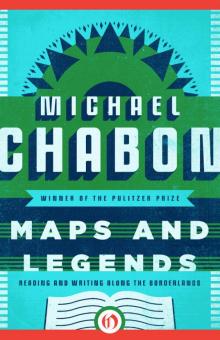 Maps and Legends
Maps and Legends The Amazing Adventures of Kavalier & Clay (with bonus content)
The Amazing Adventures of Kavalier & Clay (with bonus content) Kingdom of Olives and Ash
Kingdom of Olives and Ash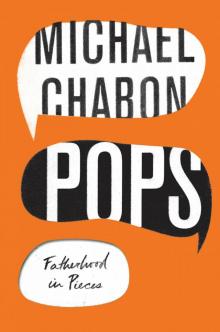 Pops
Pops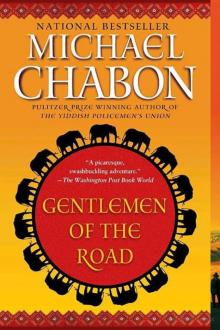 Gentlemen of the Road
Gentlemen of the Road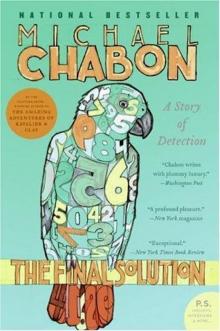 The Final Solution: A Story of Detection
The Final Solution: A Story of Detection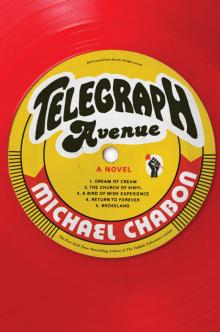 Telegraph Avenue: A Novel
Telegraph Avenue: A Novel